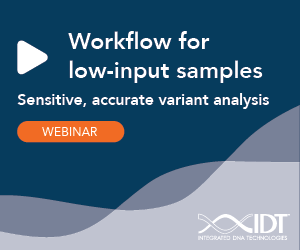The Key to Increased Sensitivity in Liquid Biopsy
Higher conversion increases data quality and accuracy of results


What are some of the benefits of liquid biopsy for cancer detection?
Liquid biopsy is sampling and analysis of saliva, blood, or other bodily fluid. Liquid biopsy enables asymptomatic screening before the patient has cancer symptoms and is a non-invasive testing method of finding cancer at the early stages. During or after treatment, a small number of cancer cells usually remain in the patient’s blood, called minimal residual disease (MRD), and can lead to relapse. Liquid biopsy and NGS can detect minute numbers of cancer cells and determine whether the treatment has completely eradicated the cancer. MRD detected by liquid biopsy can also be used to track the efficacy of treatment and adjust the therapy the patient is receiving. Compared to tissue biopsy, liquid biopsy is less invasive and therefore can be performed repeatedly over time to get a longitudinal view of cancer progression.
What are some of the challenges of liquid biopsy?
Liquid biopsy samples primarily contain normal DNA. The goal of cancer screening with liquid biopsy is to detect circulating tumor DNA (ctDNA), which is present in trace amounts, so the first challenge is having an assay that is sensitive enough to detect ctDNA. We incorporate unique molecular tags during library prep that enables error correction during the analysis phase to increase accuracy. The quality of the DNA in the sample is impacted by how the sample is collected and stored, so the second challenge is converting these trace amounts of DNA of questionable quality into something that can be sequenced. Since the input mass of DNA from liquid biopsies is typically low, you need a workflow that is very efficient from extraction through library prep to ensure that the sample is converted into sequencing results.
What is DNA conversion?
Conversion is the transformation of input material into library molecules that can be sequenced. When the library is prepared, genetic material is fragmented and ligated to adapters to prepare it or sequencing. The ability of a library prep kit or workflow to convert the input material into a sequenceable product is called the conversion rate. High conversion results in higher yields with fewer PCR cycles, lower bias, an increased sensitivity to detect low-frequency mutations, and an NGS library that accurately represents the input sample. In contrast, low conversion yields lower library complexity, lower coverage, and lower sensitive, which results in low-quality data and inaccurate results.
How can greater conversion be achieved?
We achieve greater conversion by recovering more DNA using Beckman’s Apostle MiniMax Extraction kit and increasing library complexity using the IDT xGen Prism DNA Library Prep Kit. The xGen Prism DNA Library Prep Kit has its own novel chemistry that is different from other library prep kits on the market. Most library prep kits on the market today are TA-ligation-based. Our kit has blunt-ended ligation that is combined with a novel ligase and highly modified adapters. These features help our library prep kit achieve a higher conversion of the DNA molecules from low-quality samples, which translates to higher complexity and coverage.
Besides greater conversion, how can tumor detection via liquid biopsy be improved?
Since cell-free DNA is usually present in liquid biopsy samples in trace amounts, accuracy becomes increasingly important. Unique molecular identifiers (UMIs) incorporated during library prep can remove sample-prep, library-prep, and sequencing errors, removing false positives and allowing accurate variant calling of ultra-low frequency variants. The xGen Prism DNA Library Prep Kit includes UMI-containing adapters that enable bioinformatic error correction. Combining higher complexity and coverage with a stringent error correction allows the xGen Prism DNA Library Prep Kit to deliver higher sensitivity and positive predictive value when detecting ultra-low frequency variants.


